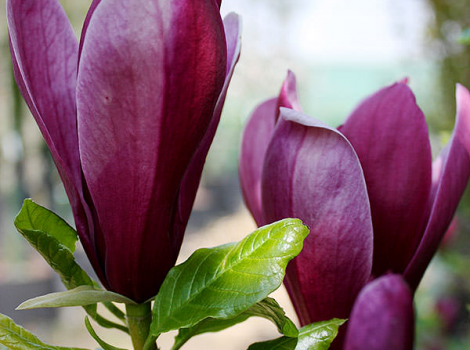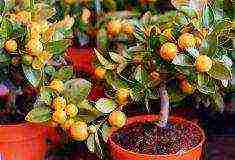Content
- 1 The history of growing grapes in the Krasnodar Territory
- 2 The best grape varieties for cultivation in the south of Russia
- 3 Reviews
- 4 Growing grapes in different regions of Russia
- 5 Krasnodar region
- 6 Crimea
- 7 Astrakhan region
- 8 Vologodskaya Oblast
- 9 Primorsky Krai
- 10 Rostov region
- 11 Vineyards "Chateau"
- 12 Russian-French project
- 13 Guided tours of the "wine kingdom"
- 14 The best wines of TM "Chateau Le Grand Vostok"
- 15 Economic effect and product quality
- 16 Manufacturing stability
- 17 Russian project "Lefkadia"
- 18 What grape varieties are grown in the Krasnodar Territory?
- 19 Farm technology "Lefkadia"
- 20 Composition of white and red wines
- 21 Rating of the best wines of the Krasnodar Territory
- 22 Consumer reviews
- 23 Homemade wines
The Krasnodar Territory is considered ideal in terms of climatic conditions for growing grapes. But even so, it is necessary to choose the right variety in order to achieve an excellent harvest.
The history of growing grapes in the Krasnodar Territory
The first mentions of vineyards in the territory where the modern Kuban is now located are equated to the 6th century BC. The Greeks willingly shared the secrets of winemaking and grape cultivation with the Slavs. With the passage of time, the wines of the Krasnodar Territory have been talked about in the capital as well.

Grapes have been grown in the Kuban for a very long time
In the 15th century, it was decided to support this industry at the state level for further development. Many varieties were imported to the Kuban from France. But the neighborhood with Georgia had a greater influence on the development of winemaking.
During the war with Turkey, vineyards disappeared in the occupied territories. And only after the end of the exhausting wars around the 19th century, viticulture began to revive. Its development was taken under control by D.V. Pilenko (Lieutenant General of the Russian Army). With the help of the Czech agronomist F.I. Heyduk, they laid vineyards, which are still operating in the Krasnodar Territory. By 1970, the Soviet Union was the third largest wine producer.
Video: Kuban farmers opt for grapes
The best grape varieties for cultivation in the south of Russia
The Krasnodar Territory has a rather mild climate. But some grape varieties can still freeze due to little snowy winters. Therefore, they practice covering the grapes with various materials.
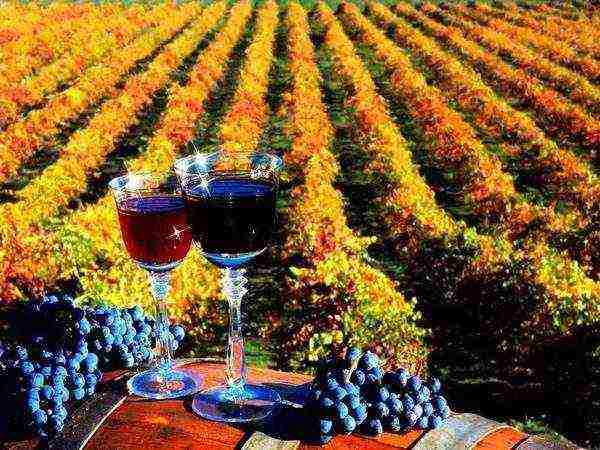
Various varieties of grapes are grown in the Krasnodar Territory, including those used in wine production
As a neighbor, who lived in the Kuban for some time, shared, many gardeners choose early and uncovered varieties. But at the same time, many use agrofibre as a shelter. After all, winter there is very unpredictable, although it lasts only 1–1.5 months. The temperature can vary from 15 ° C to -10 ° C. Although there were cases that the frost reached -25 ° C.
Particular attention is paid to the treatment of plants from pests. They develop rapidly in warm and humid environments. Large areas of vineyards can die because of them.
Many varieties of grapes are planted on the plots, selecting the most suitable ones through experiments. My neighbor has three favorite varieties:
- Nastya (or Arcadia). An early and frost-resistant variety. But still it is better to cover it in case of severe frosts. Fruiting very well;
- Rochefort. An early variety with large clusters of grapes;
- Novocherkassk sweet. It produces a good harvest and is resistant to most diseases.
Grape varieties of Krasnodar selection
The best yields can be obtained from varieties adapted to the climate and soil composition. For the Krasnodar Territory, the best choice is the varieties of the Anapa Zonal Experimental Station of Viticulture and Winemaking (AZOSViV). They are distinguished by high yield and quality of berries.
The AZOS produces not only technical varieties for the production of wines, but also canteens, which differ in terms of maturity. At the same time, they are suitable for the soil-climatic zone of the Krasnodar Territory and are immune to most fungal diseases.
As a result of painstaking and long work of AZOS breeders, copyright certificates in 2011 were obtained by varieties:
- Fantasy. "Parents" - varieties Yangi Er and Criulyansky. The vine has large, rounded, light green leaves. The lower part is without pubescence. Flowers are bisexual. The bunch is strong, medium-dense. Weighs approximately 450-500 g. The berries are large, in the shape of an elongated oval. When ripe, they have a bright pink color. The juicy pulp is under the dense skin and has 1–2 seeds. The taste is harmonious, with a refreshing sourness. The sugar content reaches 180 g / dm3 with an average acidity of 6.5 g / dm3. The variety belongs to the early ones. Resistant to frost down to -20 ° C and gray mold infection. The yield reaches 130–160 kg / ha. Farmers appreciate it for its stable fruiting and transportability.
- Winner. The variety was bred by crossing the Muscat of Hamburg and Nimrang. Leaves in the summer are dark green, large, round, medium-dissected. The flowers are bisexual. The bunch is conical with a wide base. The average weight was about 500 g. The highest weight of one bunch was recorded - 3 kg. The berries are round, large, dark red. The fleshy flesh is found under the dense skin. The winner belongs to the early ripening varieties. Fruiting occurs in the 3-4th year. Average yield - 125 kg / ha. The variety is poorly resistant to frost and does not regenerate well after damage. Medium resistant to pests and diseases. Berries do not differ in transportability, therefore they are mainly used for conservation, fresh and for drying. The taste of the fruit is estimated at 8.8 points.
- Taman. Obtained by crossing the varieties Cardinal and Criulyansky. The leaves are large, drop-shaped. Sparse pubescence of the reverse side. No pollinator required. The bunch is loose, wide conical in shape, the average weight is 570 g. The berries are dark red, juicy, oval in shape. Taste score of 9 points. The variety belongs to the very early ripening period. Disease and local pest resistance is good. The yield is about 150 kg / ha.
- Early white. The variety was bred by crossing the Pearls of Saba and the Samarkand hybrid. Flowers are bisexual. The bunches are large, wide conical in shape. Weight varies from 400 to 850 g. Berries are white-yellow, large, oval. The weight of one berry reaches 5-6 g. The skin is thin and elastic, but strong enough. According to the ripening period, they are classified as early table varieties. The yield is 130 kg / ha. The variety is appreciated for its taste (score at tasting 8.9 points) and the appearance of the berries. The disadvantages include low frost resistance.
- Ruby AZOS. No pollinator is required for the variety. It has bisexual flowers. Medium-sized conical clusters. Weight varies from 190 to 240 g. The berries are round, dark blue with firm pulp. Ruby AZOS belongs to mid-season varieties. Disease and frost resistance is average. The variety is appreciated for its taste, the tasting score of which is 9.8 points.
Photo gallery: grapes bred in the Krasnodar Territory
Non-covering varieties
Non-covering varieties are a conditional concept that directly depends on the place of cultivation. If there is little snowfall in winter, then in any case it is better to protect the vine from frost. You can not make a solid shelter, but simply sprinkle with dry leaves or cover with agrofibre.
Of the non-covering varieties for cultivation in the Krasnodar Territory, the following can be distinguished:
- Amur breakthrough. A medium-ripening variety with resistance to frost down to -40 ° C, diseases, rot and insect damage. Wines and juices are made from dark raspberry berries.
- Crystal. Transfer frosts down to -29 ° С. Resistant to mildew and gray rot. The fruits are white or dark green. Used for the production of wine.
- Platovsky. Has a second name - Early Dawn. The variety is very early, capable of withstanding frosts down to -29 ° С. The berries are white in medium size clusters. To increase yields, it is recommended to remove stepchildren and weak branches.
- Amethyst. An early variety that is immune to diseases and can withstand frosts down to -32 ° C. The dark purple berries begin to ripen in late August and September.
- Kay Gray. The variety is early maturing, which can withstand temperatures as low as -42 ° C. The shoots are powerful and vigorous, but the berries are small, with a specific flavor of Isabella. The variety is resistant to mildew, black and gray rot. It is used mainly for the production of dry wines.
- Sharov's riddle. Medium-yielding variety that can withstand frosts down to -34 ° C. The dark blue berries have a strawberry aroma. In the conditions of the Krasnodar Territory, it is recommended to pay attention to protection against oidium.
- Maurice Earley. The frost resistance of the variety is up to -36 ° С. The berries are dark purple in color, closer to black. The crop is harvested in September. For faster ripening of the berries, all the leaves are removed around the vine.
- Valiant. An early variety that can withstand frosts down to -46 ° C. The berries are small, dark blue in color. Clusters are medium in size and quite dense. Berries are consumed fresh, used to make juice and wine.
Photo gallery: grape varieties grown without shelter
Early varieties
The conditions of the Krasnodar Territory make it possible to plant grapes of different ripening periods. Thanks to this, you can eat fresh berries for 3 months.
Residents of the Kuban recommend having several vines of different ripening periods. It is good if they also differ in color and size of berries, as well as taste. Thus, you can divide the berries according to their purpose. Some will be ideal for fresh consumption, others will make delicious juice, and some can be kept fresh for up to 3 months. This is exactly what the locals do.
Early varieties that are best suited for cultivation in the Krasnodar Territory include:
- Pearls Saba. The berries ripen at the end of July. After planting, it begins to bear fruit in 2-3 years. Resistant to fungal diseases. The berry flavor is rated 8.1 on a 10-point scale.
- Madeleine Angevin. The berries begin to ripen from the beginning of August. The quantity and quality of the crop depends on the pollinator. The Shasla variety is considered the best. The weight of the bunches is from 120 to 230 g. The taste is estimated at 7.6 points. Recommended for planting in the northern regions of the Krasnodar Territory.
- Shasla white. It begins to ripen in mid-August. Fruiting already in the 2nd year after planting. The bunches reach a weight of about 150 g. The taste is estimated at 7.6 points. The berries are used not only for local consumption, but also for export. They have good keeping quality and transportability.
- Shasla nutmeg. It is found very often among amateur winegrowers in the Krasnodar Territory. Ripening begins in the second half of August. Resistant to fungal diseases. Begins to bear fruit after planting in 2-3 years. The berries are of medium transportability and are mostly used for local consumption. The taste is rated at 8.3 points.
- Chaush. Begins to ripen in the third decade of August.It has unisexual flowers, therefore the proximity of the pollinator is necessary. The best option is Chasselas. The average weight of a bunch is 410 g (some reach 600 g). It is mainly used for local consumption and production due to poor transportability.
- Hungarian Muscat. Ripening begins at the end of August. Full fruiting occurs 4–5 years after planting. The bunches are small. Their weight varies from 60 to 220 g. The taste is estimated at 8.6 points. It is mainly used for local consumption and the production of juices, which have a mild taste and honey notes in the aroma. It is not recommended to plant in regions with high rainfall. Excess water can cause the berries to crack.
Photo gallery: early grape varieties for the Krasnodar Territory
Late varieties
Late varieties are cultivated mostly in the southern regions of the region. Mild and short winters are desirable for good fruiting. The whole vine can die completely from frost. If ripening takes place at temperatures below 20 ° C, then the berries will be small and tasteless.
Common late varieties grown in the Krasnodar Territory include:
- Donskoy white. Has a ripening period of 150-155 days. Berries are green-yellow in color, large, oval in shape. The flesh is crispy and tastes good. The flowers are female, so a pollinator is essential. The best for this variety are Senso and White or Hamburg Muscat.
- Karaburnu. Large ovoid berries, yellow with a green tint. They have a pleasant sweet and sour taste and crispy flesh. Large clusters have good transportability. The yield is good from year to year, there is no peeling of berries and shedding of flowers. Requires shelter for the winter.
- Moldova. The berries are large (weighing about 55 g), dark purple in color. Under the dense skin is crispy and fleshy flesh. The bunches have an average weight of 400 g. The variety tolerates transportation well and has a high keeping quality up to 180 days. Resistant to mildew and gray rot.
- Nimrang. It is considered one of the best table varieties in the world. Flowers are unisexual. The varieties Black Kishmish, Saperavi, Hungarian Muscat are well suited as pollinators. The berries are oval, large, white-yellow in color with a pinkish tinge. The keeping quality and transportability of the fruits are high. They are mainly used fresh, for making juices and wines, for drying.
- Odessa black. The berries are medium-sized, round, black in color with a purine tinge. The pulp is juicy, with a cherry-thorny aftertaste. The bunches are small, weighing about 200 g. The variety is characterized by increased frost resistance and is able to withstand frosts down to -22 ° С.
- Taifi pink. It belongs to one of the most valuable table varieties. The berries are dark pink, oval in shape. The flesh is firm and crispy. Has a harmonious ratio of sugar and acid. The bunches are large, weighing from 500 to 800 g.
Photo gallery: late ripening grape varieties
Reviews
It is much easier to grow grapes in the Krasnodar Territory in comparison with other regions of Russia. Despite the warm climate, there are some peculiarities here. So, choosing the right variety can significantly increase the yield. It is also necessary to take into account the proximity of some varieties.
It is generally accepted to consider grapes as a plant that grows exclusively in southern countries. This opinion is erroneous and irrelevant today. Thanks to domestic and foreign breeders, the range of varieties is periodically replenished with new developments, adapted to different climatic conditions, information about which is presented below.
Growing grapes in different regions of Russia
The territory of Russia is vast, so the climate in the regions can vary significantly. In many parts of the country, a crop such as grapes is successfully grown. In addition, the vine is unpretentious to the soil, the only exceptions are saline and wetlands. Before planting a seedling, the soil is fertilized with organic matter. It is enough to enrich the soil once a year. When choosing a place, it is worth considering that the life cycle of a plant is approximately 25-30 years, therefore, an indent of 1.5 m is necessary from the walls of the fence and buildings. The best planting time is autumn, namely September. But the timing may vary depending on the climatic characteristics of the regions.
 Many gardeners are engaged in viticulture, both in the south of Russia and in regions with harsh climatic conditions
Many gardeners are engaged in viticulture, both in the south of Russia and in regions with harsh climatic conditions
In order to consistently remove a good harvest from the vine, you need to choose varieties that are recommended for growing in certain conditions.
Krasnodar region
The climatic conditions of the Krasnodar Territory are considered ideal for grapes, therefore the best varieties are grown on this territory. The ratio of warm days per year, average rainfall and sunlight make a good foundation for stable fruiting in vineyards.
The main grape production is concentrated in the Anapo-Taman zone. The harvested crop is distributed to other industries for processing and markets for fresh consumption. Harvesting time begins from the third decade of July and lasts until mid-October.
In the Krasnodar Territory, grapes are grown both in an open way and using a shelter.
It is impossible to list all the varieties grown on the territory of the Krasnodar Territory, since the vineyards are constantly replenished with new developments of breeders. The following types of culture are considered the most popular:
Madeleine Angevin
 Madeleine Angevin grape
Madeleine Angevin grape
A vigorous plant with an early ripening period. Harvesting begins in mid-August. Productivity depends on the quality of pollination, the best pollinator is Chasselas, so both crops are planted next to each other. The average weight of a bunch reaches 180-200 grams. The berries contain 15% sugar and 6.7% acid.
Pearl Saba
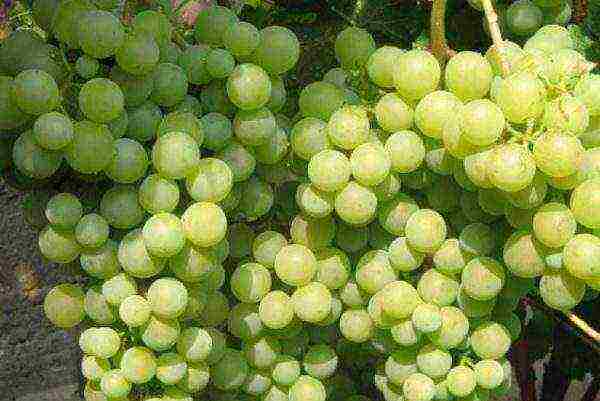 Early grape variety Pearl Saba
Early grape variety Pearl Saba
The berries ripen in late July - early August. Productivity is high (over 8 kg per bush), stepchildren bear fruit abundantly. After planting the shanks, the plant bears fruit for 2-3 years. The ratio of sugar content (16%) and acidity (7.3%) is close to the ideal value. Possesses strong immunity, resists fungal diseases. Due to the shortage of planting material, reproduction by grafting is practiced.
Shasla white
 Chassela grape white
Chassela grape white
It is one of the main ones, which is massively grown in the Krasnodar Territory. The plant enters the fruiting phase early (already in the 2nd year), the bush is formed of medium size, the immunity is strong, which can be traced in resistance to fungal diseases. The berry is distinguished by its high taste (sugar 15%, acid 6.7%) and good transportability.
Chaush
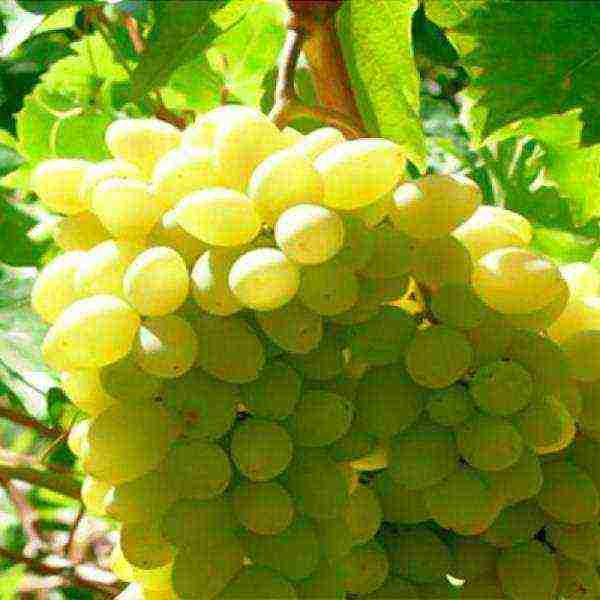 Chaush grape variety
Chaush grape variety
An early ripe variety, found throughout the region, but in small quantities. The harvest is ready for harvest in the third decade of August. On tall bushes, large clusters are abundantly formed, the weight of which reaches 420-500 grams. Productivity depends on the quality of pollination, the best pollinator is Chasselas, so both crops are planted in close proximity. Indicators of sugar content - 14%, acidity - 6%.
Hungarian Muscat
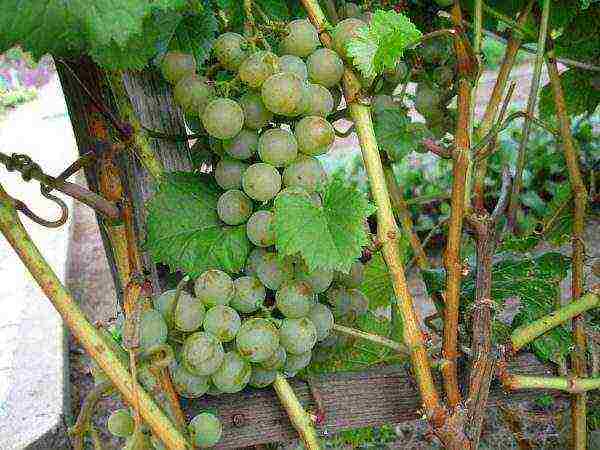 Hungarian Muscat grape
Hungarian Muscat grape
The plant enters the fruiting phase in the 3rd year after planting of seedlings. Muscat bushes are medium-sized with actively developing vines. The honey flavor of the berries indicates a high sugar content (over 20%), with a relatively low acidity (6.5%). A bunch of medium size weighs up to 160-170 grams. Designed for fresh berries and for processing into juices.
Senso
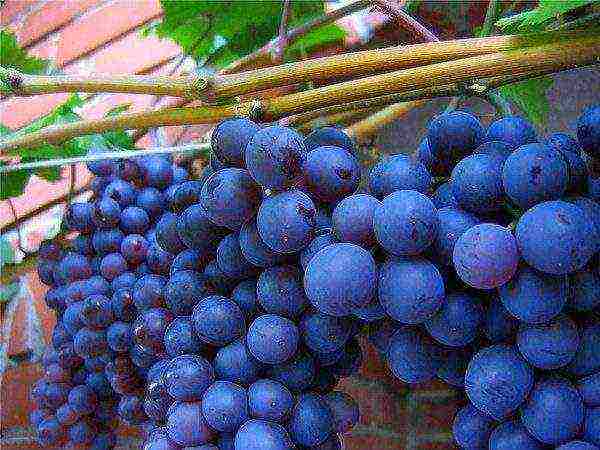 Senso grapes
Senso grapes
The plant is native to France and has a high yield. More than 7 kg of berries are removed from the bush. The grapes reach ripeness by the second half of September. The berries are large in size, dark blue in color with a characteristic waxy bloom. The taste harmoniously combines sugar content (18.3%) and acidity (7%).The mass of a bunch of medium size is 232 grams.
Crimea
An equally varied menu of grape varieties grown on the peninsula. The total number of varieties is close to a hundred. Favorable climatic conditions and soil fertility contribute to high yields. The lack of precipitation is compensated by the arrangement of the vineyards with a drip irrigation system. When planting plants, use the scheme: 3x1.5 m. The largest plantations are located in the foothill zone (Bakhchisarai district), steppe (near Simferopol), as well as in the suburbs of Yalta, Alushta, Sudak.
Among the fruitful ones, the following stand out:
Agadai
 Agadai table grapes
Agadai table grapes
A table variety originally from Dagestan, it is distinguished by a late ripening period. Harvesting begins no earlier than the 20th of September. The plant develops normally on soils with a high salt content. In addition to fresh consumption, the crop is used for canning and making juices.
Albiglio Crimean
A medium-ripening plant native to Spain. Grown for winemaking. The yield is 7-9 kg per bush. The berry contains sugar 14%, acids 6.7%.
Italy
 Grape variety Italy
Grape variety Italy
Large grapes, collected in loose bunches, the average weight of which reaches 450 grams. Yellow-amber berries have a pleasant taste with a pronounced nutmeg note.
Cardinal
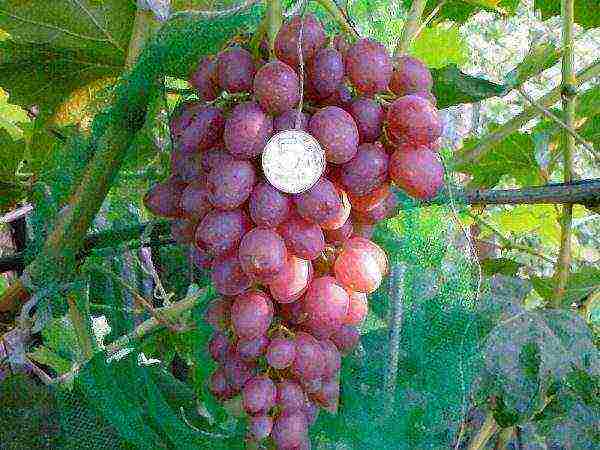 Cardinal grape
Cardinal grape
The berries ripen by the end of August. The bunch is formed loose with a lot of grapes, the average weight is 250-350 grams. The taste is not sugary, although the sugar content is at least 16-17%. Differs in resistance to fungal diseases and good transportability.
Citron Magaracha
 Grape variety Citron Magaracha
Grape variety Citron Magaracha
An early ripening wine variety. The quality of taste and presentation makes the berry edible and fresh. The weight of a cylindrical brush reaches 400 grams. Sugar content is high (23%) with an acidity of 5-7%.
Sabbat
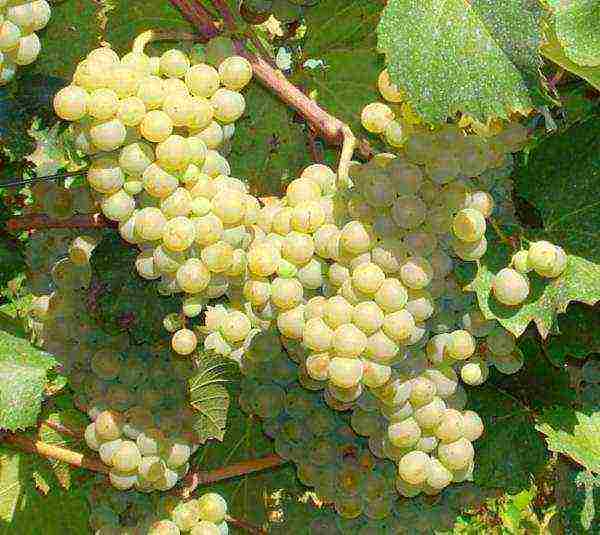 Sabbat grapes
Sabbat grapes
The culture is grown for fresh consumption and the production of wine material. White berries ripen in late September - early October. Large bunches are hung up to 280 gr. Even after storage in the refrigerator for 5 months, the grapes do not lose their taste and marketability.
Astrakhan region
Astrakhan region is a promising area for growing grapes. This is facilitated by the hot climate and the presence of the Baer hillocks. The deep bedding of groundwater leaves more chances for plants to endure winter frosts.
An important factor is the absence of insects that pose a danger to vineyards.
Over the entire period of the existence of viticulture on an industrial scale, more than 300 varieties have been tested on the Bair hills. The highest results were noted with the cultivation of the following varieties.
Codryanka (white)
 White Codryanka grape
White Codryanka grape
The plant is of a medium late ripening period with a growing season of 130-140 days. Berries of greenish-yellow color have a rounded-oval shape, the weight of one reaches 10-12 grams. Average brush weight - 600-800 gr., but there are also giants weighing 1.2 kg. The shrub can easily tolerate frost down to -23 °. Codryanka is resistant to mildew and gray rot.
Delight
 Bunch of grapes Delight
Bunch of grapes Delight
Early, with a vegetation period of 110-120 days. Differs in increased resistance to fungal diseases and mildew. Frost resistance (up to -25 °) allows you to endure severe winters under cover. The yield of Delight grapes is more than 9 kg per bush.
Radiant kishmish
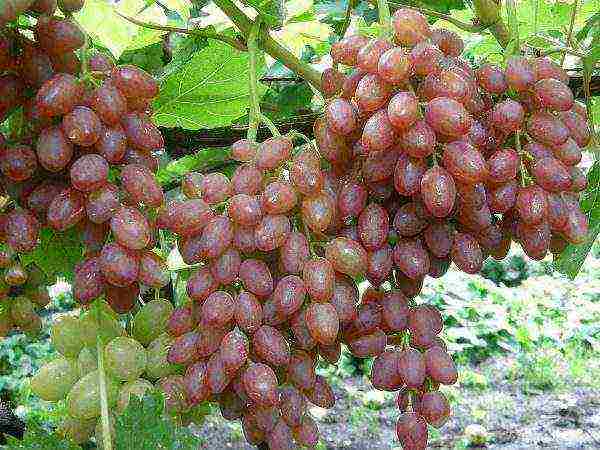 Radiant kishmish
Radiant kishmish
Pink grapes of medium early ripening period (vegetation 115-125 days). Advantages: high taste, market value, long shelf life. The weight of a bunch of medium size reaches 250-450 grams. The sugar content is 17-21%, the acidity is 6-7%.
Moskovsky
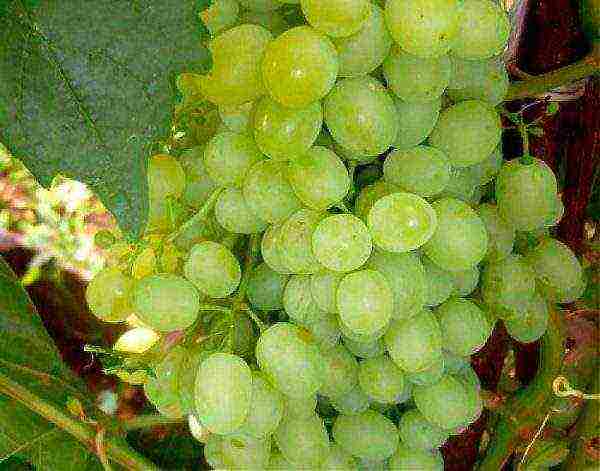 Moscow grape variety
Moscow grape variety
The plant is early ripening, has an unusual taste, filled with nutmeg and pineapple aromas. The culture is resistant to low temperatures, fungal diseases. The bunch is small, the weight does not exceed 150 grams.
Vologodskaya Oblast
The climatic conditions of this region cannot be called ideal, but even there it is possible to grow grapes. Industrialists use frost-resistant varieties. Additionally, they are covered with a special material for wintering. Private gardeners have gotten used to planting cuttings in greenhouses. Recommended for the middle band:
- Laura - large green grapes have a pleasant taste, the bushes easily endure winter;
- Shunya - large-sized dark pink fruits ripen by the end of August, the plant is resistant to disease;
- Nadezhda Aksayskaya - ripens at the end of August, in taste and externally, the berry is similar to the Arcadia variety;
- Victoria - beautiful large clusters with sweet berries, high yield (at least 7 kg per bush);
- Phenomenon - ripens in mid-August, medium-sized berries are very sweet in taste .;
- Gala - very large fruits, formed into a loose bunch, are being tested in the region;
- Cherry - early ripening plant, medium-sized pink fruit with high sugar content.
Primorsky Krai
The weather conditions of the region do not allow the cultivation of any grape varieties, therefore, special breeding ones with frost resistance are selected. Among other things for the winter period, the bushes are covered with a special material to prevent freezing.
Adele
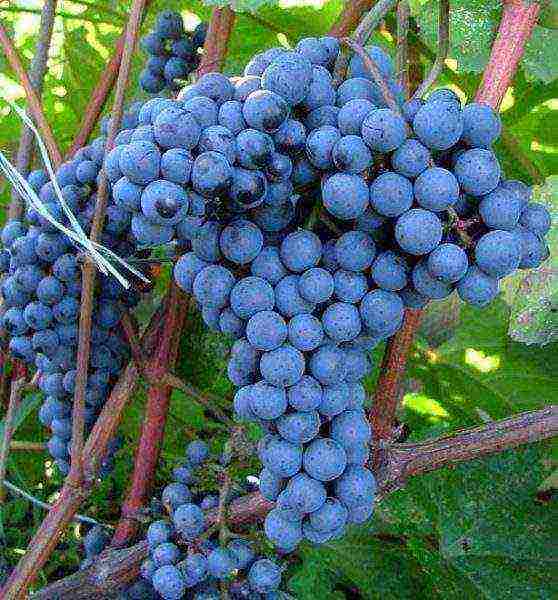 Adele grapes
Adele grapes
Designed for growing under cover. The mass of a medium-sized brush reaches 600 grams. Medium sized berries, dark blue color. The peculiarity of the variety is long-term storage, the grapes retain their presentation until the New Year holidays.
Far Eastern Novikov
 Grape variety Far Eastern Novikov
Grape variety Far Eastern Novikov
A universal variety of early ripening. Withstands frosts down to -28 °, but requires shelter for the winter period due to the climatic features of the Primorsky Territory. The bunch is small, weighing up to 250 gr., Dark blue berries with an unusual, but original taste.
Satellite
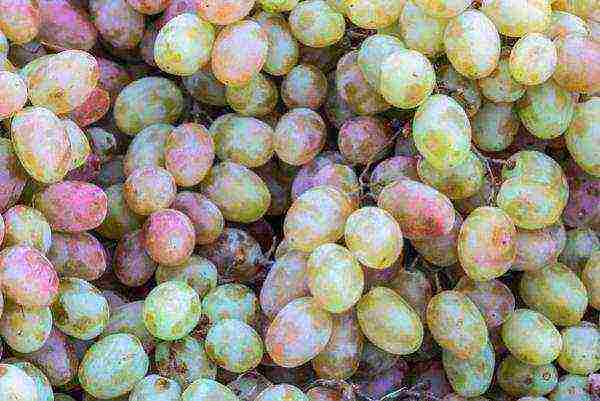 Grapes Satellite
Grapes Satellite
The plant is early maturing with greenish-yellow grapes, the weight of which does not exceed 8 grams. The advantage of the variety is frost resistance (-30 °), however, shelter is required for wintering. The fruits contain 16% sugar content and 7-9% acidity.
Pink is not a covering
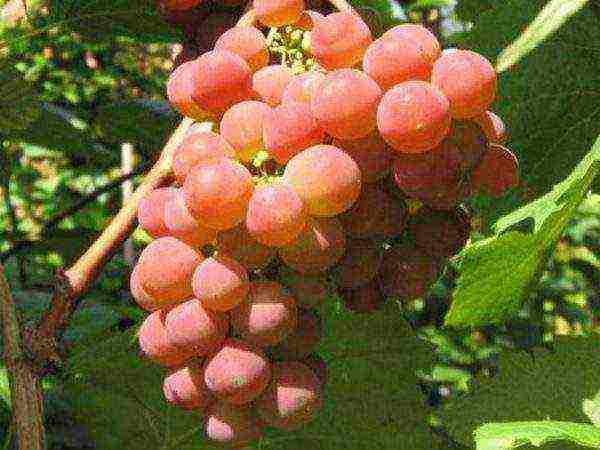 Grape variety Pink not covering
Grape variety Pink not covering
Early maturing table variety. The berries are very tasty (sugar 20%), but small. Bunch weight - 150-200 gr. The crop does not lose its presentation for a long period, even on the vine. Under proper conditions, it is stored until the New Year holidays.
Rostov region
The climate of the Rostov region is also suitable for growing the best varieties of grape selection. There is enough light, heat and moisture here. However, to select a type (covering and not covering), you should visually divide the area into 2 parts, above and below Kamensk. Non-covering varieties are recommended for planting in the south.
Not everyone is aware of the fact that wines are produced in the region, which are a real competitor to French collection drinks. Popular varieties include:
- Valentine;
- Autumn black;
- Mascot;
- Arcadia;
- Somerset Sidliss et al.
Every year, vineyard owners practice updating the assortment of varieties, using proven varieties of grapes and the latest developments. New approach and application of innovative technologies allows you to increase the profitability of agricultural enterprises, bringing their achievements to the world level.
It is pleasant to spend time with friends over a glass of good wine.Recently, the range of these products has become very large, so it is difficult for an ordinary consumer to choose a particular brand.
The wines of the Krasnodar Territory, created by Russian and French winemakers at the Chateau le Grand Vostok plant, are distinguished by their unique taste and aroma. Production facilities are located near the Anapa resort, in the Crimean region and in the Lefkadia farm.
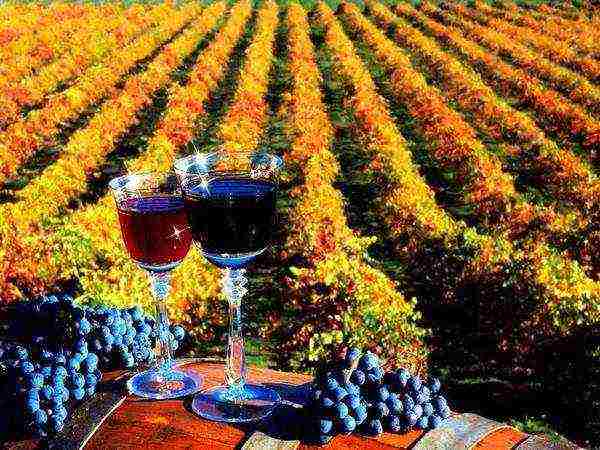
Vineyards "Chateau"
Vine plantations in Krasnodar lands are occupied by many kilometers of plantations. Fruit-bearing shrubs are spread over 250 hectares, and a young vine is gaining strength on 120 hectares.
Winemakers of France, who know a lot about good wine, have chosen to plant vineyards on the lands of Krasnodar, having previously studied the climatic and soil characteristics. Under the sunny sky, in tiered order on the hills and slopes, located 150-350 meters above sea level, vine plantations are spread. This location provides plants with maximum access to sunlight. The soil, the base of which consists of marl and limestone, favorably influences the formation of the root system of plants.
Initially, already existing land was used for growing vines, and this is about 500 hectares. But over time, a young vine was brought from France. Nursery Mercier provided the project with new grape seedlings of various varieties, which were planted for wine production.
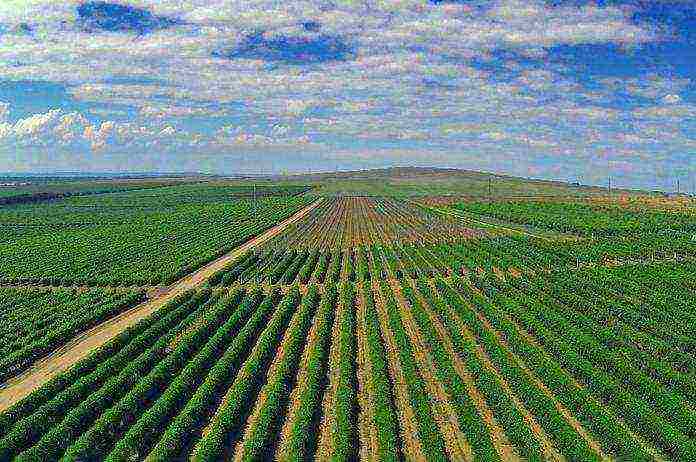
Russian-French project
The choice of the French was not accidental, because it was in the south of Russia that the harvest was harvested for the preparation of high-quality competitive wine that satisfies the tastes of refined gourmets. During the 90s, the largest wineries had new owners running their own businesses. The choice fell on the Aurora winery, whose director was looking for reliable financial flows. In the 80s, the enterprise under the leadership of N. Pinchuk did not cut down plantations, but tried to plant new seedlings, the harvest of which was sold to other wineries for the production of wine in the Krasnodar Territory. French experts scrupulously analyzed the activities of Aurora. It was this farm that Chateau le Grand Vostock chose from all the others.
In 2003, the French experts in the design of wineries - M. Bryullonov and F. Maziere, developed a project for the future enterprise, all the equipment of which was manufactured in France. Even oak and steel containers and corks were delivered from abroad.
All wines of the Krasnodar Territory are sealed with corks with the company logo. So, white wines are bottled in Burgundy type bottles, and for red wine they use Bordeaux style. Production technologists use microfiltration with cold filling. This helps to obtain a "live" wine that retains all the aromas of the sun and grapes.
French specialists strictly monitor all stages of the production of the drink. The designer of the plant F. Maziere, introducing advanced technologies in winemaking, equipped the plant with modern equipment imported from France. This is what made it possible to obtain unique wines with a mild taste and high quality.

Guided tours of the "wine kingdom"
Anyone can get acquainted with the wine kingdom and see how the best wines of the Krasnodar Territory are produced. Guided tours around the territory of the winery are held from the second half of May to the end of September.
The tourist program includes:
- wine tasting;
- sightseeing tours of plantations;
- rest on the shore of the lake.
As a gift, guests receive a souvenir version of a bottle of Chateau le Grand Vostock as a keepsake. The best time to visit the winery is the harvest time, which falls on the first days of September.
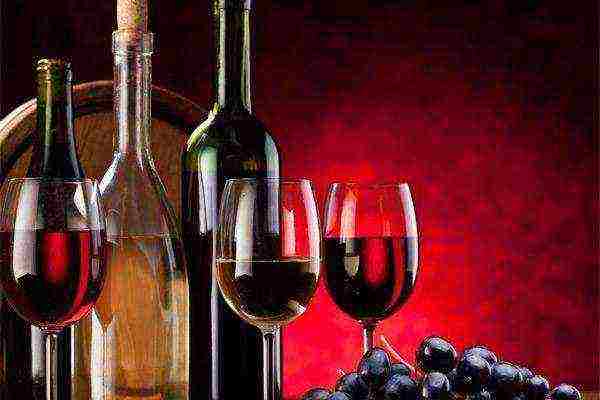
The best wines of TM "Chateau Le Grand Vostok"
The French-Russian production, producing the best wines of the Krasnodar Territory, reviews of which can be found in the guest book, has numerous awards and diplomas, occupying a leading position in the European wine market.
The most popular are:
- "Lands of the South".
- "Royal Oak".
- Selecion Cabernet Saperavi.
- "Solo".
- Cuvee Karsov.
Arriving guests wishing to get acquainted with the art of winemaking and taste the wines of the Krasnodar Territory, can comfortably settle in the hotel, ready to receive visitors in any season. The influx of tourists occurs in late spring - early autumn. There are a lot of people who want to learn the intricacies of winemaking.
Wine production in the Krasnodar Territory is developing in parallel with the direction of tourism. Visitors to Chateau le Grand Vostok, getting acquainted with the technology, learn a lot about the history of the drink.

Economic effect and product quality
Wine factories in the Krasnodar Territory effectively use the principle based on the traditions of European winemakers, when a berry goes through a full cycle from ripening to filling bottles with wine. This idea was brought to life by Malesan William Pitters and backed by the board of directors of Chateau le Grand Vostock. The foundation of its foundation lies in economic benefits, because all production processes are located on the same territory, while ensuring product quality indicators and economic benefits.
Manufacturing stability
Despite the cold winter in 2005-2006 and the February frost of minus 28 degrees, which destroyed up to 200 hectares of plantations, the campaign was able to make up for the losses by 2008 by compacting the plantings of vines. This growing method has led to a decrease in the number of berries, but has helped to obtain a wine with a unique taste.
Today, the wines of the Krasnodar Territory, the names of which we meet in stores, reach more than a million liters per year. Each season, the farm plants about 25 hectares of young seedlings.
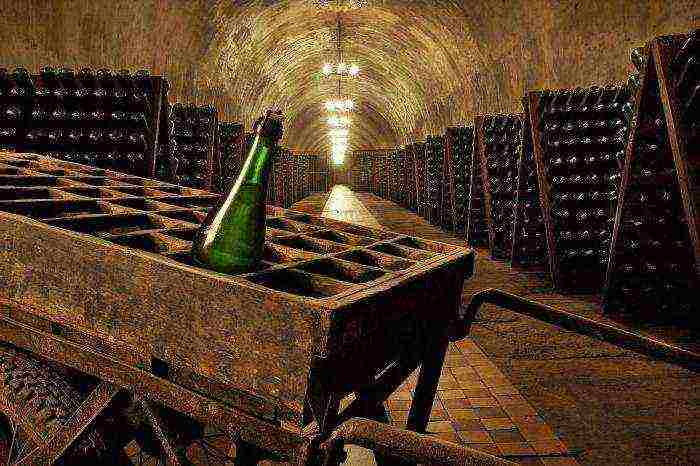
Russian project "Lefkadia"
No less promising and unique is the Russian farm "Lefkadia", which works in several directions at once:
- winemaking;
- cheese making;
- vegetable growing.
Lefkadia is located in the foothill zone of the Caucasus. The natural climate of the zone is very similar to that of Tuscany, an Italian area. Vineyards occupy up to 80 hectares of area here, located on clay, sandy and limestone lands. The farm has laboratories corresponding to international standards, equipped with modern technology, which is served by a team of world-class winemakers. The beverage production process is controlled at all stages by qualified specialists.
What grape varieties are grown in the Krasnodar Territory?
The first landings appeared in 2006-2007. The seedlings were brought from France. Today the farm grows both domestic and European grape varieties. The most popular are:
- Chardonnay.
- Sauvignon Blanc.
- Marsan.
- Rusan.
- Riesling.
- Cabernet Sauvignon.
- Cabernet Franc.
- Grenache.
- Malbec.
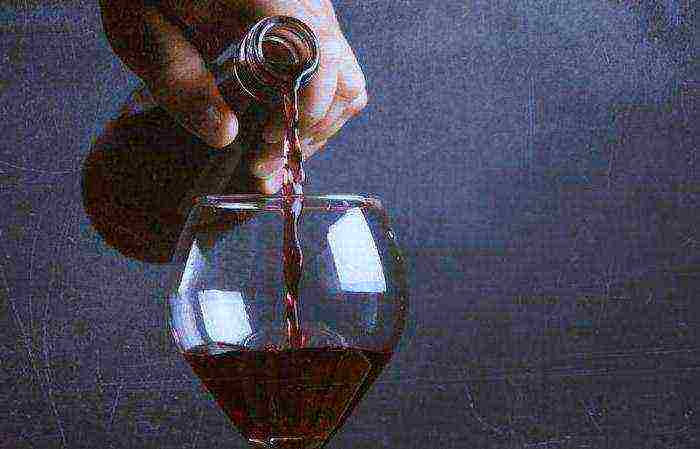
Farm technology "Lefkadia"
Located close to vineyards, the plant quickly processes raw materials that make their way into oak and metal tanks without additional pumps. The small size of the filling line allows you to protect the contact of the finished drink with the surrounding air.
Containers for aging and storage of wine are made using American and Adyghe oak varieties. Experts know that not only the type of wood affects the quality of wine, but also the period of heat treatment of barrels allows you to get up to nine different wine tastes. In the barrel storage of the farm, a system is used that allows wine to be mixed without opening the container itself.
In parallel with the production of competitive wines, Lefkadia produces cheeses and vegetables of the Pure Food brand.
The main criteria that govern the economy are:
- non-use of nitrate and pesticidal fertilizers;
- rejection of chemical additives;
- ban on growth regulators and GMOs.
Thanks to these factors, Lefkaria's products have received the organic brand in Russia. This suggests that not only the products themselves, but also the lands on which they were grown, and the seed itself is not processed with any chemical compounds, except for organic matter.
Composition of white and red wines
Wine has beneficial properties, and this is not surprising, since it contains various trace elements. The drink has a low protein content (2 g), and during the clarification of the wine material, their amount is significantly reduced.
Of the mineral salts, potassium occupies the largest share (from 700 to 1600 mg). Magnesium and calcium in the composition of wine are approximately equal, from 50 to 200 mg. The content of phosphorus salts is 100-200 mg, but sodium in the drink is about 20-250 mg.
It is worth noting that wine is very rich in iron, so you can often hear that in case of anemia and low hemoglobin, it is recommended to consume a small amount of red wine. This trace element is ionized, due to which absorption into the cells of the body occurs very quickly. The composition also contains such useful substances as zinc, copper and manganese.
Vitamin C is completely absent in the drink, but there are a lot of representatives of group B:
- riboflavin;
- pyridoxine;
- thiamine;
- niacin;
- pantothenic acid.

Rating of the best wines of the Krasnodar Territory
The South of Russia is rich in wine-making enterprises, whose drinks take part in various domestic and international exhibitions. September was marked by an overwhelming success, as a few days ago a tasting competition was held in Austria, in which a huge number of brands participated. The selection of the best samples was carried out blindly. Winemaking companies "Chateau Tamagne" and "Fanagoria" received high awards: 3 gold and 8 silver.
This is a great achievement, especially considering that approximately 13,000 wines from over 1,800 brands from 41 countries participated in the competition.
Three gold medals were awarded to TM "Fanagoria" wines:
- Cabernet One Hundred Shades of Red (2013).
- "Saperavi one hundred shades of red" (2014).
- Vintage Cahors (2011).
The last sample was also included in the top three strong wines.
Consumer reviews
The wines of the Krasnodar Territory have found their admirers in their homeland. Many consumers leave positive reviews about the quality of the product. For example, dry wines TM "Fanagoria" received the following assessment from buyers:
- the drink has a pleasant taste;
- despite the fact that the wine is dry, acid is not felt;
- no aftertaste of alcohol;
- the drink goes well with fruits and black bitter chocolate;
- acceptable cost of the product (about 270 rubles for a 0.7 liter bottle).
The range of Krasnodar wines is very large, so that every gourmet can choose a drink that suits his taste. In addition to red and white, dry, semi-sweet and dessert, there are delicious sparkling wines. Champagne is one of the most popular drinks for ladies, without which no romantic dinner, wedding or New Year can do.
People who have taken an excursion tour of the winery at least once in their lives, learned the secrets of production, attended a tasting, and take with them indelible impressions of this amazing and picturesque land.
Homemade wines
Many travelers and connoisseurs of a good glass of wine take with them not only a bottle of "Chateau", "Lefkaria", but also homemade wines of the Krasnodar Territory, prepared according to old recipes of local residents. Homemade wines surprise with their variety and combination of flavors.
How pleasant it is on a cold evening in the family circle to remember the sunny sky of Crimea, endless vineyards stretching to the horizon, the aroma emanating from the vine, and drink a glass to those who prepare a drink that excites our hearts.
